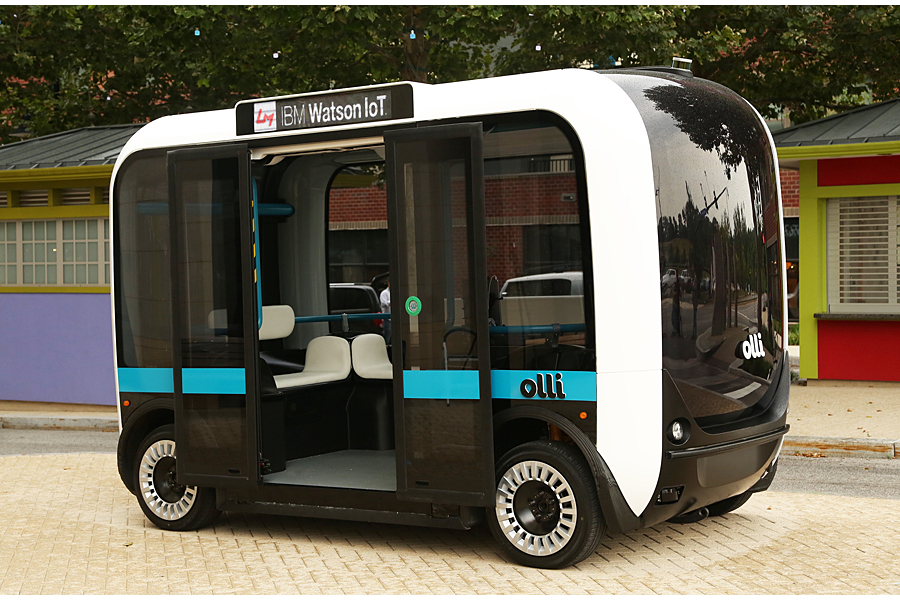Meet Olli, America's first driverless public shuttle bus
What do you get when you cross self-driving artificial intelligence, 3-D printing, and public transportation? Olli, an autonomous, electric shuttle with room for 12 passengers.
Local Motors, a manufacturer known for its focus on open-source vehicle designs, unveiled Olli on Thursday at its new facility in National Harbor, Md., a development just outside Washington D.C.
To test Olli, Local Motors plans to offer free rides to the public around the development in what is believed to be the first public trial of a completely self-driving vehicle in the United States, reported The Washington Post. In February, the Netherlands launched a fleet of WEpod driverless buses, which can carry six passengers, on the campus of Wageningen University in a central Dutch agricultural town.
Miami-Dade County has bought two Olli shuttles, and Las Vegas has bought one. The two municipalities are expected to pilot the shuttles by the fourth quarter of this year, Adam Kress, Local Motors' director of public relations and content, tells The Christian Science Monitor in a phone interview Thursday.
Olli arrives well ahead of 2020, when eleven automakers have committed to having their driverless technology ready, according to Tech Insider. As Local Motors pushes automakers and their new rivals – including Google, Apple, and Uber – to develop their self-driving vehicles faster, it and other driverless buses offer a different perspective on the future of autonomous cars: municipalities, universities, and other organizations and institutions could use Olli to transport the public in a ride-sharing experience from point A to point B.
"We want to be on the leading edge of reinventing mobility, and changing the way we move around, with the goal of making it smarter. If you look at the congestion in the inner city, and people flocking to urban centers, we can't all have cars. It just doesn't work," says Mr. Kress.
"Olli is the kind of vehicle and kind of autonomous experience people are naturally comfortable with hailing themselves, hopping in, and hopping off. Ollie would even literally thank you for the ride," says Kress, referring to the IBM Watson services that make Olli a smart van.
Local Motors has produced two prototypes of Olli so far, according to The Washington Post. The battery-powered vehicle is an open-sourced design, in which numerous companies have contributed to how it looks and operates.
In addition to the 3-D printed fender Local Motors manufactured, and its autonomous driving technology, Olli has services powered by IBM Watson, the company's artificial intelligence platform. That means Ollie can process information, interact with passengers and ask them their destination, explain why they made certain driving decisions and even use face recognition to identify them and their favorite destinations, according to Local Motors.
"Cognitive computing provides incredible opportunities to create unparalleled, customized experiences for customers," Harriet Green, the general manager of IBM Watson's Internet of Things, Commerce, and Education, said in a statement. "IBM is excited to work with Local Motors...exploring the art of what's possible in a world of self-driving vehicles and providing a unique, personalized experience for every passenger while helping to revolutionize the future of transportation for years to come."
Like Uber, Lyft, and other ride-hailers, Olli could connect to a fleet management system, and a consumer could order a ride through an app. Where Olli stands apart, however, is the number of passengers it can transport at any one time. Municipalities, universities, and even theme parks could offer the service to move passengers around, much like public transportation today.
Olli, then, is vastly different from the prototypes of other self-driving vehicles, which have room for maybe a handful of passengers – a problem which Robin Chase, the former chief executive of Zipcar, warned about in 2014. Ms. Chase said the future of driverless vehicles could either be heaven, or its opposite. In the latter scenario, everyone will buy an autonomous car, as the Monitor reported in November.
"If single-occupancy vehicles are the bane of our congested highways and cities right now, imagine the congestion when we pour in unfettered zero-occupancy vehicles," Chase wrote in CityLab, a project of The Atlantic.
Olli, and other ventures like it, could bring about Chase's "heaven" scenario, removing more vehicles from the road: a vision shared by its chief executive, Jay Rogers.
"A full win for Olli, when we can hook up the victory flag and say we're done here, is when a city says no more cars on our streets," Rogers told The Washington Post.





